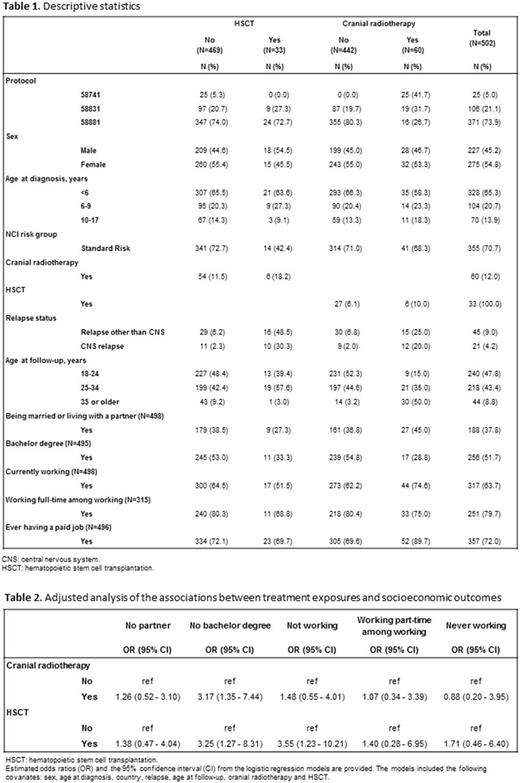Abstract
Background
Over the last 30 years, there has been a considerable progress in the survival of childhood acute lymphoblastic leukemia (ALL). With survival rates exceeding 85%, the long-term effects are of major interest. Exposure to treatments may have severe toxicities such as cognitive deterioration after cranial radiotherapy (CRT) and impaired general physical functioning after hematopoietic stem cell transplantation (HSCT). These late effects may negatively impact the socioeconomic functioning of survivors. The aim of this study was to assess the socioeconomic status of adult survivors of childhood ALL treated in EORTC trials and the effect of patient's and disease characteristics and treatment modalities.
Methods
Between 2012 and 2017, a cross-sectional follow-up study was performed among childhood ALL (and acute lymphoblastic lymphoma) survivors enrolled between 1971 and 1998 in EORTC trials (58741, 58831/2 and 58881) by centers from France and Belgium. Patients who were younger than 18 years at diagnosis and older than 18 years at the time of the follow-up were eligible. Those whose postal address could be retrieved were invited to fill out a questionnaire with information about their socioeconomic situation. Additionally, the treating institutions provided medical updates.
The following socioeconomic outcomes were evaluated: being married or living with a partner, having a university degree, having a job, working part-time among those having a job and history of having a paid job.
Results
Among 1429 eligible patients, 502 (35.1%) filled out the questionnaire, 862 (60.3%) were lost to follow-up and 65 (4.5%) refused to participate. The distribution of age and NCI risk group at diagnosis, initial central nervous system involvement and relapse within one year after diagnosis was comparable between respondents, those lost to follow-up and those who refused to participate.
Out of 502 survivors participating in the study, 66 had experienced a relapse (13%), 33 (7%) received HSCT (26 after relapse) and 60 (12%) were treated with CRT (36 in first line treatment, Table 1). The median time between the diagnosis and the socioeconomic evaluation was 20 years (range: 13-42). The median age at follow-up was 25 years (range: 18-53). Among survivors at school at the time of the diagnosis, 22% retook one and 6% two or more years due to the disease and 4% were unable to finish their education. Interestingly, 21% of the survivors had more and only 10% had less educational ambitions due to the disease. More than a half of the survivors had at least a bachelor (undergraduate) degree, 64% had a job and 38% were married or lived with their partner. Among those 25 years of age or older, the percentages for obtaining a bachelor degree, having a job and having a partner were 54%, 84% and 57%, respectively.
In a multivariate model including sex, age at diagnosis, country, age at follow-up, relapse, HCST and CRT both treatments were associated with a higher probability of not obtaining a bachelor degree (OR=3.25, 95% CI: 1.27-8.31 for HCST and OR=3.17, 95% CI: 1.35-7.44 for CRT) and HSCT was associated with not having a job (OR=3.55, 95% CI: 1.23-10.21, Table 2). We found no evidence of associations between treatment exposures and having a partner. The associations between age at diagnosis and risk group at diagnosis and the socioeconomic outcomes were not statistically significant. Having a relapse was associated with a higher probability of not having a partner (OR=1.99, 95% CI: 1.05-3.77) and working half-time (OR=2.40, 95% CI: 1.03-5.58), adjusting for sex, age at diagnosis, country and age at follow-up. These findings were consistent with those from a sensitivity analysis performed among survivors aged 25 years or older.
Conclusion
This large study showed that, overall, long-term childhood ALL survivors enrolled in EORTC trials between 1971 and 1998 were characterized by a high level of socioeconomic participation. However, HSCT and CRT were associated with negative socioeconomic outcomes. Our study adds to the body of evidence supporting the omission of CRT when other treatment alternatives are sufficient, like in first line treatment. It also indicates the need to provide special support to the most vulnerable groups of childhood ALL survivors, in particular those who received HSCT.
No relevant conflicts of interest to declare.
Author notes
Asterisk with author names denotes non-ASH members.


